Tidio vs Landbot: Which is the best AI chatbot? [2025]
Tidio and Landbot are two of the most popular no-code AI chatbot platforms for lead generation, with marketers often asking which is better for building and automating marketing flows.
This article will help you quickly figure out which tool fits your business, goals, and level of customization needs.
We’ll cover ease of use, pricing, features, AI capabilities, workflow customization, integrations, reviews, pros and cons, and which audience each tool is best for.
Let’s dive in 👇
Should you consider Big Sur AI instead?
Zero setup deployment: instant time-to-value
Unlike Tidio or Landbot, Big Sur AI requires no flow setup or UI configuration. You can deploy a conversion-focused bot to your website or landing page in under two minutes. No training or path mapping needed.

Always-optimized conversations without the guesswork
Big Sur AI uses pre-trained, data-backed prompts fine-tuned for lead gen. Your visitors get smart qualifying questions and closing language out of the box—no testing or reworking replies needed.

For example, B2B sites can launch a bot that captures contact info, booking intent, and pain points based on what works across thousands of sites.
AI-powered learning without maintenance
With Big Sur AI, your flows receive continuous updates and performance tweaks automatically. The system adapts based on latest marketing research and behavioral data, so your chatbot gets smarter over time without you editing paths or adding rules. Teams never have to remap flows or maintain logic; it just works.

Built-in AI workflows
Big Sur AI syncs lead info, meeting bookings, and emails straight to your CRM, calendar, or Slack—no API wiring or Zapier chains.
High-value leads get routed automatically for follow-up, making it seamless for marketers to trigger sales sequences or demo requests, even if your stack changes over time.

Tidio vs Landbot: Overview
| Factor | Tidio | Landbot |
|---|---|---|
| Public reviews | 4.7 ⭐ (G2), 4.8 ⭐ (Capterra) | 4.7 ⭐ (G2), 4.8 ⭐ (Capterra) |
| Our rating | 8.5/10 ⭐ | 8/10 ⭐ |
| Core purpose | Live chat and chatbot platform for lead generation, automation, and support | No-code chatbot builder for highly customizable, conversational landing pages and lead gen flows |
| Best for | Ecommerce, SMBs, teams seeking unified inbox & automation with live chat | Marketing teams, agencies, businesses wanting interactive lead funnels and personalized landing bots |
| Typical use cases | Lead capture, website chat, customer support, FAQ handling, automated sales | Lead qualification, survey bots, interactive forms, event/booking flows, guided onboarding |
| Hosted vs self-hosted? | Hosted (SaaS) | Hosted (SaaS) |
| Open Source? | No | No |
| Pricing model | Subscription (tiered by features/volume) | Subscription (tiered by feature/volume/branding) |
| Free plan? | Yes (Starter, 50 conversations/month) | Yes (limited features & branding; 30 chats/month) |
| Customization level | Branding, chat widget styles, trigger rules, moderate flow customization | Highly customizable: chatbot logic, visual workflows, conditional routing, custom UI elements |
| Ease of use | Very easy (drag-and-drop UI, quick setup, live chat focus) | Medium (no-code builder, some learning curve for advanced flows) |
| LLM integrations | Native Tidio AI, GPT-3.5 support for some plans | GPT-3/4, OpenAI, custom AI block integrations |
| Other integrations | Shopify, WooCommerce, Messenger, Zapier, HubSpot, Mailchimp, Slack, many CRM/tools | HubSpot, Stripe, Google Sheets, WhatsApp, Zapier, Slack, API/webhooks, Messenger |
| Workflow capabilities | Prebuilt flows, conditional branching, canned responses, auto-routing | Advanced workflow builder, conversational forms, conditional logic, multi-step bots |
| Deployment options | Website widget, Messenger, mobile app, email | Website, WhatsApp, Messenger, custom URL, iframe, popups, widget |
| Team collaboration | Shared inbox, agent assignment, roles, internal notes | Collaboration via team roles, shared bot editing, handover blocks |
| Pros |
✅ Seamless live chat + chatbot ✅ Very fast setup ✅ Unified inbox & omnichannel ✅ Strong ecommerce integrations |
✅ Extremely flexible logic & design ✅ Visual builder is powerful for marketing flows ✅ Easy to launch branded bots ✅ Great for interactive lead gen |
| Cons |
❌ Custom flows less advanced ❌ Deep marketing automation limited ❌ Some features paywalled ❌ Custom integrations require higher plan |
❌ Learning curve for complex bots ❌ API/webhook limits on lower plans ❌ No live chat agent functionality (bot-only focus) ❌ Can get costly at scale |
| Why choose it? | 👉 Best for fast, no-code, unified chat + chatbot on your site, especially for ecommerce or SMBs needing all-in-one chat and lead capture with easy setup. | 👉 Best if you need flexible, highly interactive lead generation or marketing bots, or want to build advanced forms, survey flows, or multi-step user journeys with lots of UI control—without coding. |
Tidio vs Landbot: How do their features compare?
Tidio outpaces Landbot in AI-powered automation
Tidio’s chatbot automation is more robust out-of-the-box, thanks especially to its Lyro AI engine.
This lets users deploy intelligent, conversation-driven bots with little setup effort and no coding.
For example, marketers can launch a chatbot to answer FAQs, qualify leads, or book meetings using just a few clicks and some sample FAQs.
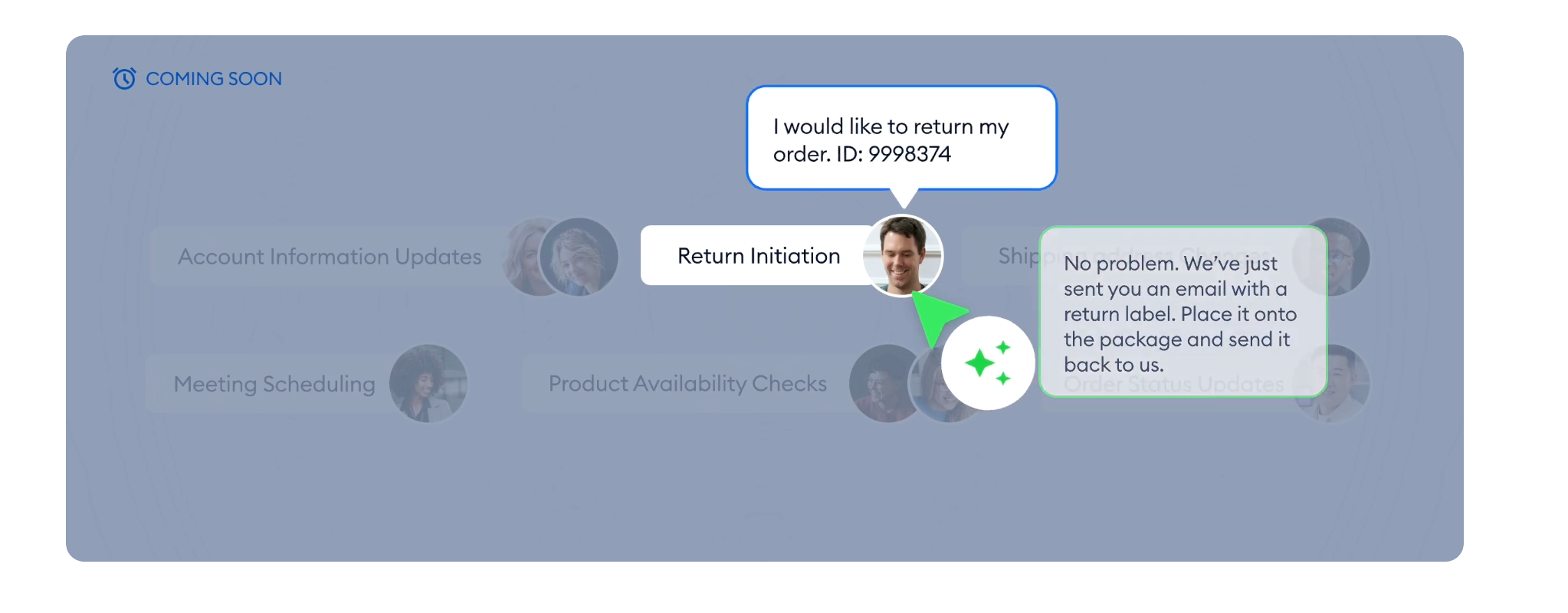
Tidio’s AI can quickly learn from chat history and provide tailored responses, reducing the manual upkeep that Landbot’s rule-based builder often requires.
This is critical for growing businesses that want to scale lead generation without dedicating hours to bot configuration.
Smarter autoresponses
The AI will recognize intent like “I need a demo” or “Can you send me pricing?” and automatically move the contact into the right marketing funnel.
With Landbot, this is possible, but it takes more manual mapping of paths and conditions.
Landbot wins on advanced conversational flow design
Landbot’s visual conversation builder is highly praised for its flexibility and clarity when designing complex flows.
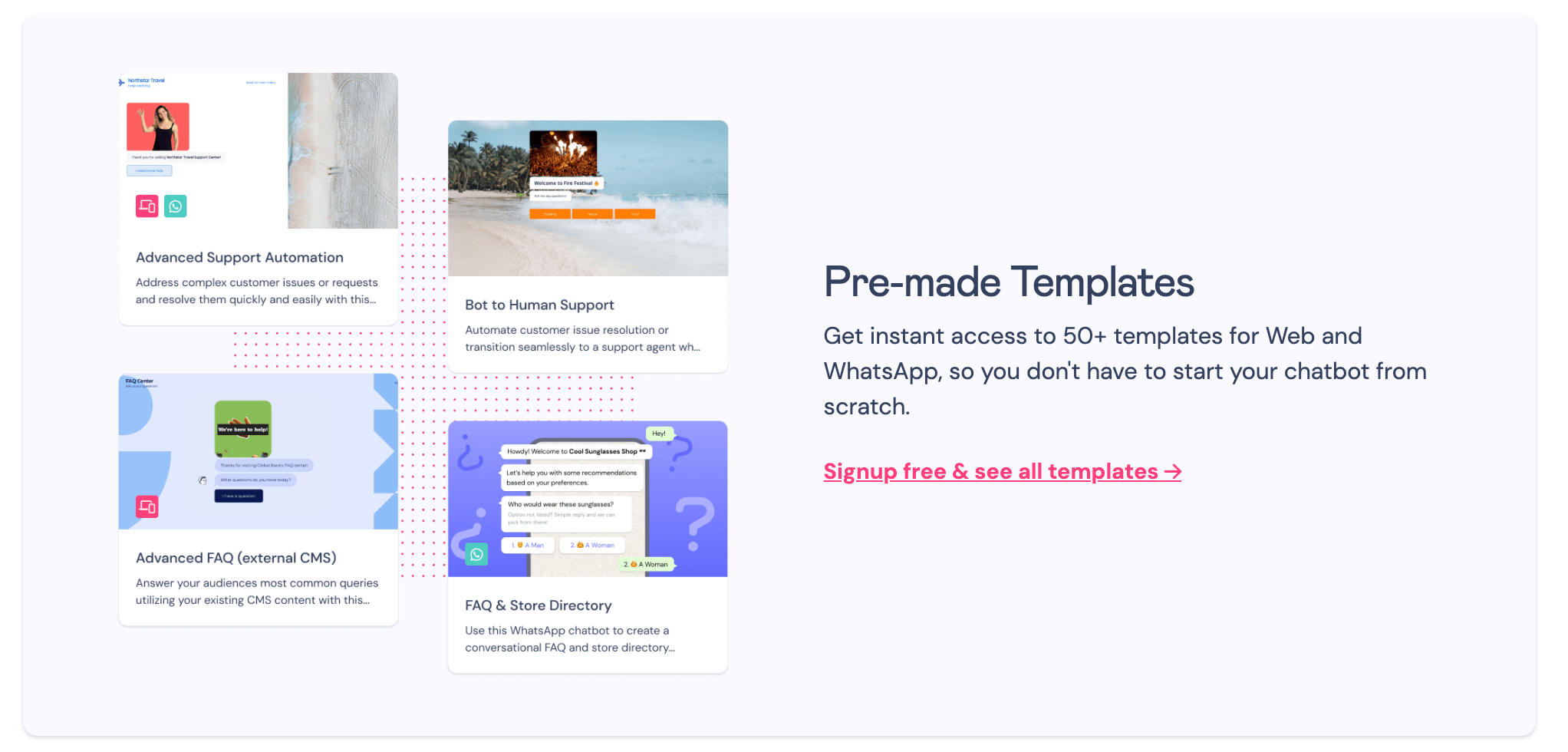
Its drag-and-drop builder enables conditional logic, quick replies, carousels, and external API calls—all without leaving a no-code environment.
This is especially powerful for marketers needing to segment user personalities or build multi-step quizzes that adapt on the fly.
More control, less guesswork
Landbot’s “flow view” lets you see all conversation paths at a glance, making complicated marketing automation possible without any scripting.
Tidio’s chatbot designer is more linear and offers less clarity for multi-branch experiences.
Tidio is favored for live chat and omnichannel inbox
Tidio’s interface merges live chat, email, Messenger, and Instagram DMs into one unified inbox.
This unified communication is a big win for teams that handle inquiries from multiple sources and want to follow up with leads regardless of where they came in.

For instance, a lead can start a conversation on your website and continue it in their email without any disconnect.
Landbot, on the other hand, primarily focuses on web-based conversation experiences and requires extra effort (or integrations) to achieve a similar result.
Cross-channel continuity
Tidio keeps the full conversation history regardless of where the customer replies, ensuring seamless context for marketers and sales reps.
With Landbot, much of this needs third-party plugins or manual transfer.
Landbot is better than Tidio for WhatsApp and SMS automation
Landbot outpaces Tidio in building no-code bots that operate on WhatsApp and SMS channels.
Landbot offers deep native workflows for WhatsApp Business API, unlocking expanded lead gen and nurturing in markets where WhatsApp is the lead engagement platform.
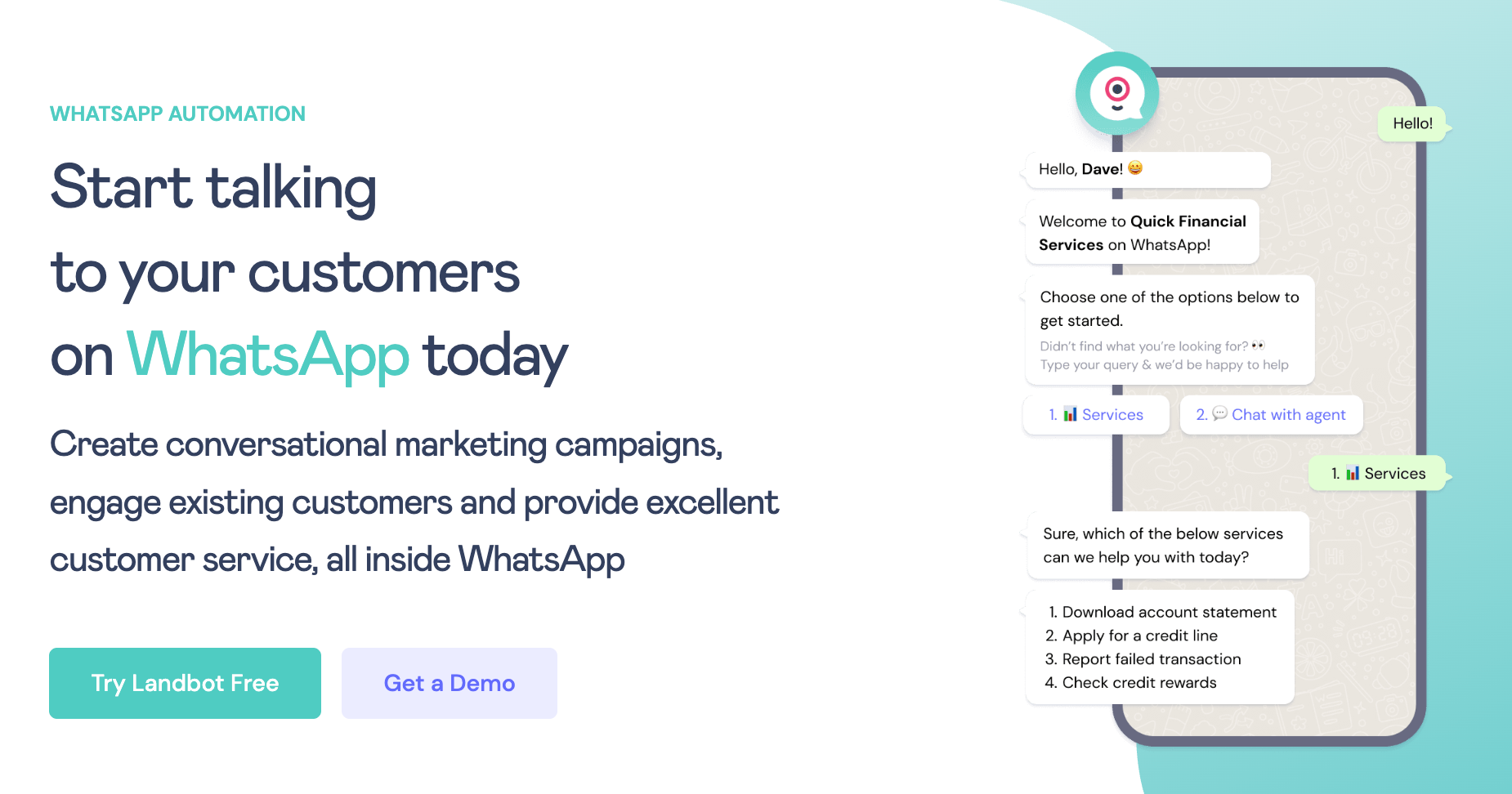
Sending event reminders, running polls, or nurturing leads through personalized drip campaigns via SMS/WhatsApp is much more plug-and-play with Landbot.
Tidio’s focus is stronger on web widgets and social customer support. WhatsApp integrations are only available on higher-tier plans and can require more setup.
Tidio wins on quick deployment and template library
Tidio’s template library is extensive, offering ready-to-launch bots for abandoned carts, order tracking, lead capture, or re-engagement.
Marketers love being able to deploy these flows within minutes, adjusting basic copy and branding as needed.
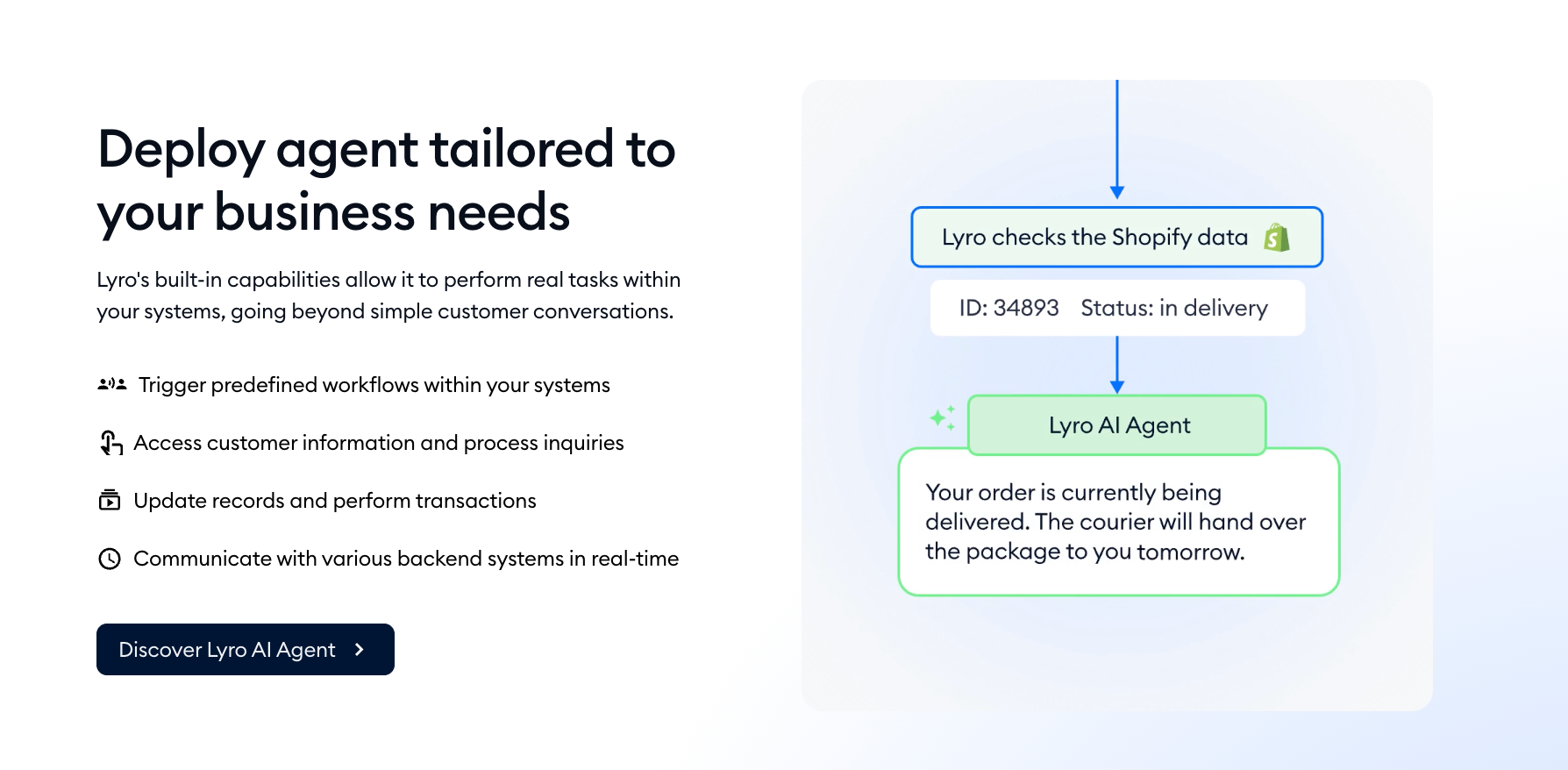
Landbot also has templates, but they tend to focus on the mechanics of lead capture rather than the specific marketing use case.
Setting up your first bot on Tidio is often as simple as picking “Product Recommendation,” making a few tweaks, and hitting publish—ideal for small teams or those new to chatbots.
Landbot is more favored by customers for integrations with external apps and CRMs
Landbot’s builder offers deeper native and Zapier-based integrations with external tools such as Salesforce, HubSpot, Airtable, and Google Sheets.
This makes it much easier to build workflows where, for example, a lead qualifies in a Landbot chat and their info is instantly pushed into your CRM, added to a marketing campaign, or triggers a Slack notification.
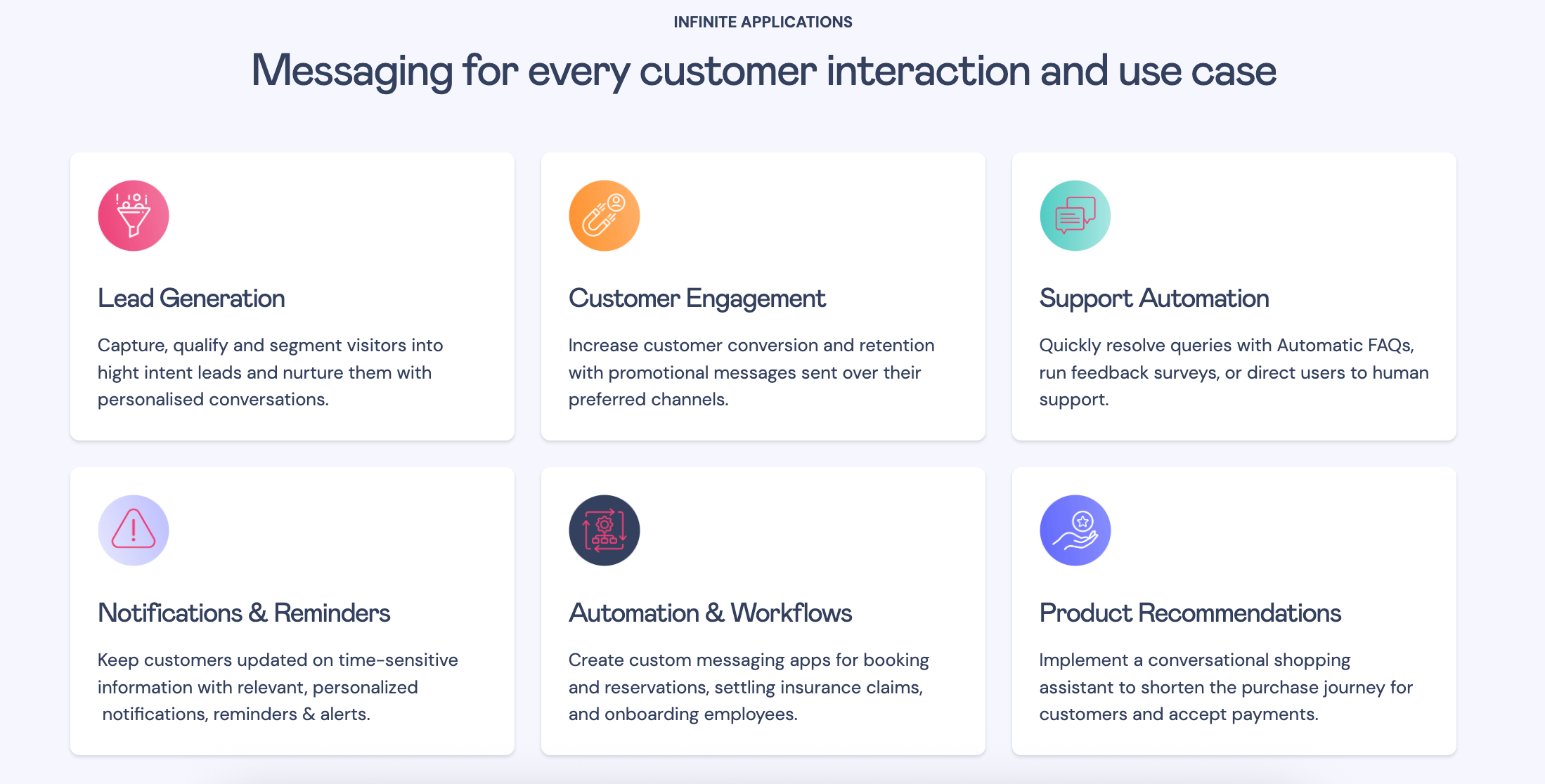
Landbot’s integrations reduce the need to patch together workflows with extra middleware, which is especially valuable for businesses juggling diverse lead sources.
Tidio vs Landbot: How much do they cost?
Tidio's pricing: quick overview
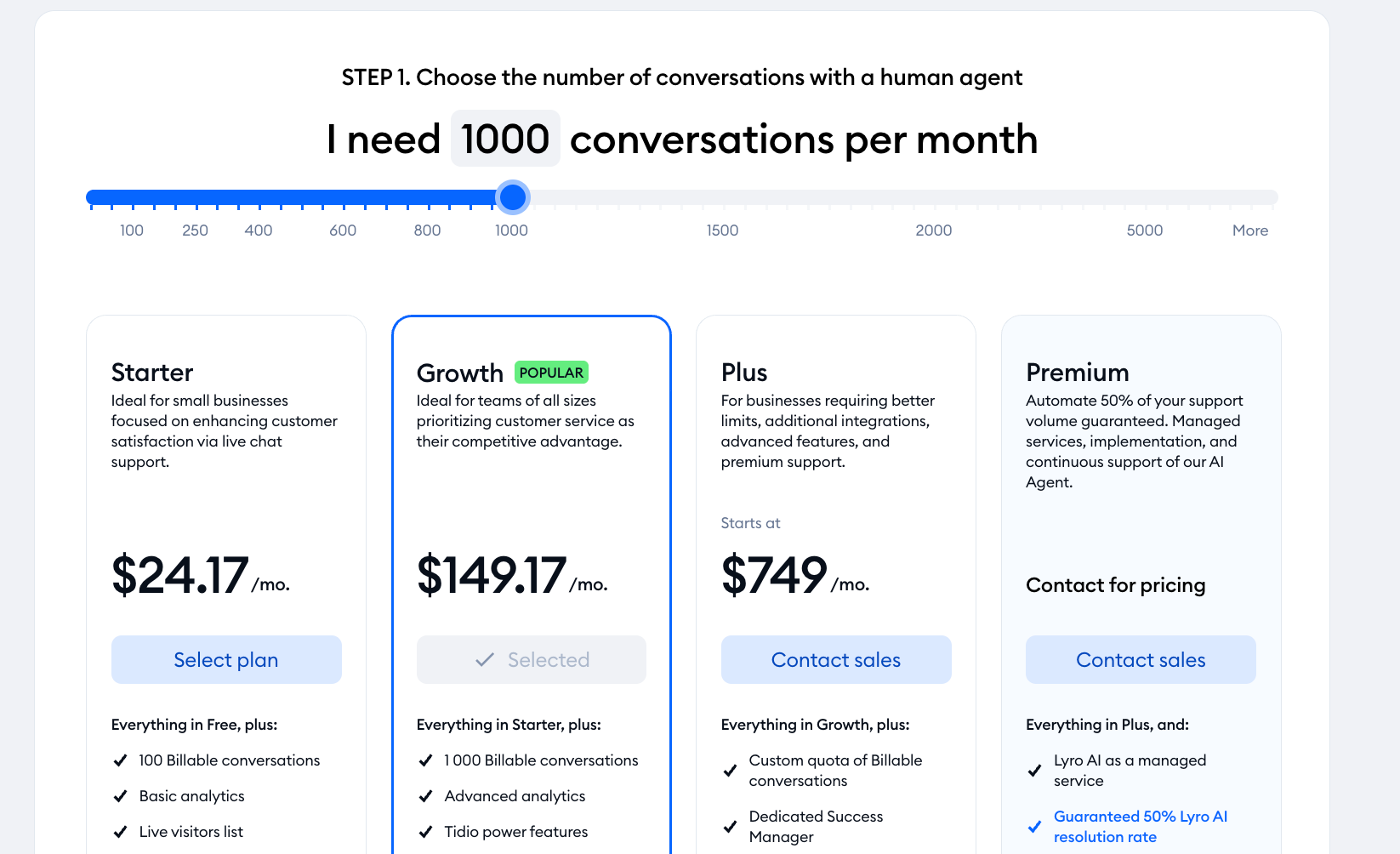
- Free plan includes basic live chat, ticketing, and limited active chatbots
- Paid plans (billed monthly) as of June 2024:
- Starter: $29/month for up to 3 operators, 1,000 unique visitors, basic automation
- Communicator: $25/month per seat for live chat, unlimited conversations
- Chatbots: $29/month for chatbot features, up to 2,000 monthly triggers
- All-in-one (Tidio+) from $394/month for advanced automations, higher usage, and priority support
- Chatbot usage and additional seats can increase monthly bills
Landbot's pricing: quick overview
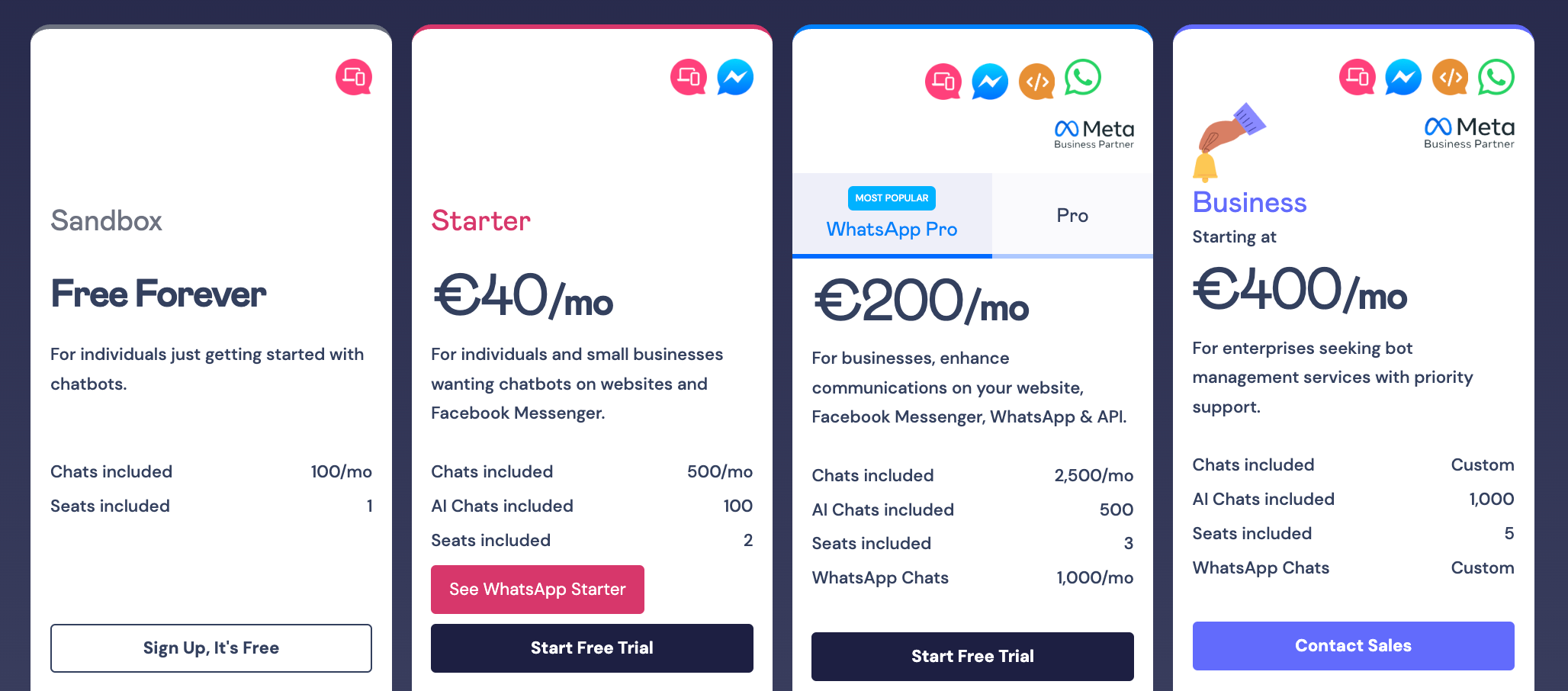
- No entirely free plan, but a free trial is available
- Paid plans (billed monthly) as of June 2024:
- Starter: $49/month for 1,000 chats, basic integrations, 1 seat
- Pro: $99/month for 2,500 chats, advanced logic, webhooks, multi-seat
- Business: Custom pricing for advanced needs and high volumes
Key differences between each pricing structure
- Tidio has more granular, mix-and-match plan options for live chat, bots, and operator seats
- Landbot offers fewer bundle options but more generous automation and logic features on higher plans
- Landbot does not have a true free plan, while Tidio has a functional freemium offer (with usage caps)
How generous are each free plans?
- Tidio:
- Free plan gives 50 live chat conversations and basic chatbot access (up to 100 users/month)
- No credit card required to get started
- Landbot:
- No ongoing free plan—only a 5-day free trial with full feature access
- Forces upgrade after the trial ends
How does pricing increase with heavy usage?
- Tidio:
- Costs scale with both operator seats and automation volume (chatbot triggers, visitors)
- Can become expensive for larger teams or high-traffic sites since plans/usage add up
- Landbot:
- Pricing primarily scales with conversation volume and feature/unlock tiers
- For high-volume chat or advanced integrations, you'll need Pro or Business plans
Other potential surprises
- Tidio:
- Add-ons (AI agent, email marketing) have separate fees
- Some integrations and automation logic gated behind higher tiers
- Landbot:
- API and webhook access only on Pro plans or higher
- Chat volume overages can increase monthly fees
Tidio vs Landbot: Integrations & workflows
Integration breadth
Tidio connects natively with Shopify, WordPress, Wix, and WooCommerce. It supports integration with tools like Zapier, Mailchimp, HubSpot, and Messenger. There’s a built-in API for custom integrations, but the strongest connections are in ecommerce and CRM.
Landbot offers native integrations with WhatsApp, Slack, Google Sheets, and Salesforce. It also leverages Zapier, Make, and Webhooks for advanced connections. Landbot’s API access is comparable to Tidio but with more pre-made templates for marketing stacks.
Automation and workflow design
Tidio’s workflow editor is visual and drag-and-drop. Pre-made automation flows (like cart recovery or customer follow-up) help marketers set up quickly. Conditional logic and triggers are easy to configure.
Landbot stands out with its block-based chatbot builder. Users can build complex flows with conditional steps, rich data collection, and multi-channel logic. Workflow customization is slightly deeper than Tidio, with granular control over user paths.
Multi-channel capabilities
Tidio allows chat automations across website widgets, email, Instagram, and Messenger. Most automations focus on web and messenger experiences.
Landbot supports website chat, WhatsApp, Facebook Messenger, and even SMS. Its workflows can hand off conversations across these channels, offering a seamless multi-channel experience.
Bottom line
Tidio is ideal if you need fast e-commerce integrations, straightforward automations, and CRM sync.
Landbot is better suited for those who want granular workflow control, wider messaging channel coverage, and advanced integrations without coding.
Tidio vs Landbot: AI capabilities
When comparing Tidio and Landbot for AI-driven marketing flows, consider the following tactical differences:
- Tidio focuses on AI-powered live chat with a strong omnichannel inbox, letting you manage email, Messenger, Instagram, and website chats in one console. It offers AI automation for lead qualification, routing, and basic initial response handling, with generative AI chatbots available for conversational flows and FAQs.
- Landbot specializes in building interactive, logic-driven bots for website and WhatsApp using an intuitive drag-and-drop builder. Its AI is best suited for guided conversations, qualifying leads with quizzes and forms, abandoned cart recovery, and scheduling demos with conditional logic. Native GPT-3 support enables simple AI assistance but is less developed for advanced natural language understanding.
Key concrete differences include:
| Tool | Best for | Key AI features | Drawbacks | Pricing |
|---|---|---|---|---|
| Tidio | Live agent chat, quick lead capture, customer support |
- AI-powered conversational flows - Natural language FAQ bots - Multi-channel intent detection - Auto lead routing and tagging |
- Limited visual customization - AI only available on higher tiers |
Free (50 chats/mo); Starter: $29/mo; Communicator: $25/mo/seat; Chatbots: $29/mo |
| Landbot | Highly interactive marketing flows, lead gen, custom web chatbots |
- Drag-and-drop logic-based bot builder - GPT-3 integration for basic AI answers - Customizable conversational paths and rich media - Quick start templates for lead gen and surveys |
- Less advanced AI for natural conversation - API and advanced integrations on higher plans only |
Starter: $49/mo; Pro: $69/mo; Business: Custom |
Tidio vs Landbot: How customizable are they?
Flow building and bot design
Tidio and Landbot both offer no-code, visual flow builders, letting users design chat experiences with drag-and-drop simplicity.
Landbot gives you more granular control over conversation paths. Its builder uses a modular block system, which makes it easy to visualize branches and set custom triggers for advanced flows.
Tidio’s flow builder is also user-friendly but focuses more on simplicity; it’s easier for beginners but can feel limiting if you want complex conditional paths or multi-channel flows.
Template flexibility and branding
Landbot stands out with customizable templates for various marketing use cases (lead capture, surveys, feedback, etc.) and lets you adapt layouts, fonts, and colors to match brand style closely.
Tidio offers good template choices and branding options but with fewer layout customizations. On both platforms, you can add your colors and logo, but if pixel-perfect design or unique chatbot interfaces matter, Landbot gives you a bit more creative freedom.
AI, integrations, and custom actions
For automation and advanced actions, Landbot integrates with more marketing tools natively and supports custom webhooks and API calls inside flows.
Tidio has solid integration options (e.g., HubSpot, Mailchimp, Zapier), but custom scripting and webhooks are less flexible compared to Landbot.
Both allow you to use AI assistants, but Landbot lets you set more detailed user attributes and triggers in response to user input, which is crucial for advanced segmentation in marketing funnels.
Marketing use cases
If your main priority is to design unique and sophisticated lead gen funnels, quizzes, or conversational forms with detailed custom logic, Landbot offers more flexibility.
Tidio is best for those who value ease of use and need to launch polished, standard flows quickly without diving too deep into customization options.
For experiments or brand-heavy campaigns, Landbot gives more room to tailor every aspect of the bot experience.
Tidio vs Landbot reviews: What do customers say?
TL;DR ➔ Tidio’s reviews highlight its ease of use and solid integrations for marketing, but limited customization frustrates advanced users.
Landbot impresses with its visual flow builder and flexibility, but some users find it less beginner-friendly and pricey.
For lead gen and marketing flows, Tidio wins for fast setup and usability, while Landbot excels in user journey personalization if you’re willing to put in more work.
Here are their respective review scores on major platforms ⤵️
Tidio’s G2 score: 4.7/5 ⭐
Tidio’s Capterra score: 4.7/5 ⭐
Tidio’s Trustpilot score: 4.7/5 ⭐
Landbot’s G2 score: 4.6/5 ⭐
Landbot’s Capterra score: 4.8/5 ⭐
Landbot’s Trustpilot score: 4.8/5 ⭐
The most important is what people say in real reviews about where both tools stand out and fall short. Here’s what we found 👇
Tidio: The good
Reviewers consistently praise Tidio’s intuitive interface and easy integration with websites and ecommerce platforms:
"It took me literally 10 minutes to get my chatbot collecting leads on my site."
Customers appreciate Tidio’s ready-made templates and built-in email marketing tools, which streamline lead generation:
"We started capturing emails and answering FAQs right after install — perfect for getting started with zero tech background."
Integrations with Shopify, WordPress, and Zapier are mentioned often by marketers for "seamless automation." Many users also highlight Tidio’s efficient support team and rapid onboarding.
Tidio: The bad
On the downside, advanced users regularly mention workflow limitations:
"The bot builder is powerful, but you hit a wall fast if you want to do anything more than the basics."
Customization is seen as lacking compared to Landbot, especially for teams wanting to build more complex user journeys. Other noted issues: sporadic lags on mobile and pricing jumps with higher contact volumes.
Landbot: The good
Landbot reviews are dominated by praise for the visual, drag-and-drop chatbot builder:
“The flow builder is by far the best—super flexible, lets us map complex marketing funnels without code.”
Agencies and marketers highlight how easy it is to personalize user journeys and blend multiple channels (web, WhatsApp):
"We could run quizzes, appointment bookings, and fun lead gen—all fully branded and interactive."
Strong support and clear documentation help teams ramp quickly. The ability to reuse blocks and create multi-step flows is a recurring positive.
Landbot: The bad
Landbot’s flexibility makes it more powerful, but some beginners feel overwhelmed by the options:
“The builder’s flexibility is great, but there’s a learning curve. Not plug-and-play like Tidio."
Several reviews mention pricing as steep once you scale up features or contacts. Some users cite limited native integrations and having to rely on Zapier for common tools. Occasional comments note that certain advanced features “feel beta” or require workarounds.
Tidio vs Landbot: Pros and Cons for each
TL;DR:
💬 If you need a user-friendly, plug-and-play solution for lead capture and live chat with essential automation, Tidio is faster to set up, integrates easily with most websites, and fits best for SMBs focusing on chat-based marketing.
🤖 If your priority is highly customizable, visually rich, and complex lead generation or qualification flows (especially for marketers needing logic branches and multi-step actions), Landbot offers deeper drag-and-drop options and branded experiences, but takes more effort to master.
| Tool | Best For | Key Strength | Drawbacks | Pricing |
|---|---|---|---|---|
| Tidio | SMBs, ecommerce, fast lead capture & support | Quick deployment, live chat + chatbots in one, seamless integrations | Less flexible for complex flows, advanced automations and integrations often paywalled, limited visual customization | Free (50 chats/mo). Paid: from $29/mo |
| Landbot | Marketers, agencies, interactive lead gen & surveys | Powerful drag-and-drop builder, deep flow customization, strong branding and conditional logic | Higher learning curve, can be laggy at scale, complex API/webhook setup on lower tiers | Starter: €39/mo. Pro: €99/mo. Business: custom |
Both tools are strong for no-code lead gen, but the choice depends on how advanced or branded your flows need to be.
The bottom line: Which tool is better for my business?
Tidio and Landbot are both popular no-code chatbot platforms focused on lead generation and marketing flows, but they serve different priorities and business needs. Here’s a concise breakdown to help you choose the right tool based on your goals, budget, and customization preferences.
Tidio: Best for fast, easy lead gen with live chat
- Pricing: Offers a generous free plan (50 chats/month). Paid plans start at $29/month. Costs increase with usage, operator seats, and advanced features.
- Ease of use: Extremely beginner-friendly with drag-and-drop setup, fast deployment, and minimal onboarding friction.
- AI capabilities: Strong out-of-the-box with Lyro AI, natural language chat, intent detection, and omnichannel inbox for chat, email, Messenger, and Instagram.
- Key features: Unified chat+chatbot platform, seamless ecommerce integrations (Shopify, WooCommerce), ready-to-use templates, live agent handoff, basic automation, and easy CRM/email sync.
- Customization: Good for basic branding and workflow tweaks. Less ideal for complex, highly tailored chat experiences.
- Who it’s for: SMBs, ecommerce shops, and marketers who want a quick, reliable chatbot for capturing leads, handling support, and automating FAQs—especially if you don’t need advanced conditional logic or unique visual flows.
Choose Tidio if you want a plug-and-play chatbot for lead gen and support that you can launch in minutes, prefer live chat, and your business values simplicity and speed over advanced customization.
Landbot: Best for custom, interactive marketing funnels
- Pricing: No ongoing free plan—only a 5-day trial. Paid plans start higher ($49/month), with advanced logic and integrations gated at higher tiers.
- Ease of use: The builder is more visual and powerful but comes with a steeper learning curve, especially for non-technical users.
- AI capabilities: Integrates GPT-3 for basic AI answers but is less advanced for freeform, natural chat. Focus is on logic-driven, interactive experiences.
- Key features: Highly customizable conversation flow builder, block-based visual editor, deep conditional logic, support for web and WhatsApp/SMS channels, granular API/webhook integrations, advanced surveys, and branded experiences.
- Customization: Exceptional flexibility for custom logic, multi-step quizzes, and branched marketing journeys. Match your exact brand style and UX.
- Who it’s for: Marketers, agencies, and teams running interactive campaigns, quizzes, or multi-channel lead funnels who need pixel-level control and are willing to invest time into design and configuration.
Choose Landbot if your marketing thrives on interactive, multi-step flows, quizzes, and conditional logic, or if you need a chatbot that offers maximum customization and deep integration with your marketing stack.
Recommendation:
- For speed and simplicity in lead gen plus a live chat option, Tidio is the easy winner.
- For highly customizable, interactive marketing flows or campaigns where branded UX and complexity matter, Landbot is the better fit.
Ready for truly zero-setup, AI-powered deployment?
Give Big Sur AI a try! You can launch a conversion-focused bot to your site in under two minutes, no training or configuration required.


